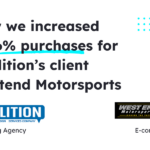![10 Copywriting Secrets Every Growth Marketer Should Know [+ BONUS] 10 Copywriting Secrets Every Growth Marketer Should Know [+ BONUS]](https://pathmonk.com/wp-content/uploads/elementor/thumbs/10-Copywriting-Secrets-Every-Growth-Marketer-Should-Know-BONUS-r12bprby92xxruf6guawq52of7ulnm86hvcs4vjfk8.png)
To effectively capture attention, evoke emotions, and drive action, one must execute the skill of copywriting. The ability to write compelling copy directly impacts conversion rates and customer engagement, which makes copywriting crucial for growth marketers.
We’ll explore 13 essential copywriting secrets that every growth marketer should know to maximize their marketing efforts.
1. Understand Your Audience
To craft compelling copy, it’s vital to understand your target audience. To achieve it:
- Conduct thorough market research to identify your target audience’s demographics, preferences, and behaviors.
- Develop buyer personas to have a clear understanding of their needs, desires, and pain points.
- Personalize your copy by using language and tone that resonates with your audience.
For example, if you’re targeting millennial gamers, you could use colloquial language and incorporate gaming references in your copy.
2. Highlight Benefits
Focus on the benefits your product or service offers rather than just listing features. Show how your offer can solve problems, make life easier, or improve their experience. Highlighting benefits helps potential customers envision the value they’ll receive.
- Identify the unique selling points and benefits of your product or service.
- Clearly articulate how your offering solves a problem or improves the customer’s life.
- Focus on the outcome and the positive impact it will have on the customer.
Instead of saying, ‘Our software has a user-friendly interface,’ say, ‘Our software saves you time and frustration with its intuitive interface that requires no technical expertise.’
3. Create a Captivating Headline
Creating a captivating headline will grab the attention of your audience and entice them to read further.
- Use powerful words that evoke emotions and curiosity:
- Select impactful and descriptive words that elicit strong emotions or curiosity in your readers.
- Clearly communicate the value or solution your product provides
- Your headline should clearly convey the main benefit or solution your product or service offers.
- Focus on the outcome or transformation your audience can expect by using your offering.
- Highlight the key value proposition that sets your product apart from competitors.
- Keep your headline concise, ideally within 8-12 words to maintain impact.
- Use strong and active language to create a sense of urgency or excitement.
- Consider using numbers or time frames to add specificity and make the headline more compelling.
Example: “Discover the Secret to Skyrocketing Your Sales in Just 7 Days!”
In this example, the headline incorporates the following elements:
Powerful words: ‘Discover’ and ‘Skyrocketing’ evoke a sense of excitement and curiosity.
Clear value communication: The headline promises a solution to increase sales, addressing a common pain point for businesses.
Conciseness: The headline is concise, consisting of only 8 words.
Specificity: The inclusion of ‘in Just 7 Days’ adds a time frame, making it more compelling.
This headline captures attention, creates curiosity, and communicates a tangible benefit, making readers eager to learn more about the secret behind boosting their sales.
4. Write for the Website
Users tend to skim and scan content rather than read every word. To effectively write copy for websites, there are specific considerations and best practices to keep in mind:
- Use clear and concise headings, subheadings, and bullet points to make your copy scannable.
- Use H2, H3, and other metadata to highlight the sections and most relevant parts of your copy.
- Highlight key information with formatting techniques such as bolding or italics to draw attention to important details.
Avoid jargon, buzzwords, and overcomplicated sentences. Focus on clarity and simplicity.
5. Use Persuasive Language
Incorporate persuasive language techniques like power words and emotional triggers. Persuasive copy should evoke strong emotions, and establish credibility to encourage action.
- Examples of power words include “exclusive,” “irresistible,” “transform,” “guaranteed,” or “breakthrough.” These words can capture attention and stimulate interest in your offering.
- Appeal to your audience’s emotions to forge a deeper connection with your message.
- Identify the emotional benefits your product or service provides, such as joy, relief, or security.
Craft copy that taps into those emotions and showcases how your offering fulfills those needs.
6. Use Storytelling
Storytelling is a powerful tool to connect with your audience on an emotional level.
- Share stories that highlight your brand’s values and mission.
- Craft narratives that demonstrate how your brand makes a positive impact or contributes to a larger cause.
- Connect with your audience by showing the human side of your brand and engaging them through shared values.
Mastering the art of storytelling is Patagonia, the renowned outdoor clothing and gear company, through their initiative called “The Footprint Chronicles.” This campaign serves as a transparent platform that shares the company’s journey toward sustainability and ethical manufacturing.

Through powerful storytelling, Patagonia takes their customers on a behind-the-scenes exploration of their supply chain, environmental impact, and efforts to drive positive change. By sharing narratives and videos about their factories, material sourcing, and community initiatives, Patagonia invites customers to join their mission and make more informed choices. They emphasize the human stories of the people behind the products, the environmental impact of their operations, and the steps they take to reduce waste and protect natural resources.
7. Inject Personalization
Injecting personalization into your copy is an excellent way to make your audience feel seen and understood. Some practical things you could start doing are:
- Address the reader directly: Use pronouns like “you” and “your” to speak directly to the reader. This creates a sense of one-on-one communication and makes the copy feel more personal and relevant.
- Tailor content to specific needs and pain points. Research and understand your target audience’s needs, challenges, and desires. Craft your copy to directly address those specific pain points and offer solutions. Use language that resonates with their experiences and reflects their aspirations.
- Use dynamic content or variables to populate information based on the reader’s profile or behavior. This can include their name, location, or previous interactions with your brand. Personalized elements demonstrate that you value and remember each individual, enhancing their connection with your brand.
Netflix is a great example of excelling in personalization. Using algorithms and machine learning, Netflix personalizes the user interface, showcasing categories and content that are likely to appeal to each individual viewer. In terms of content and copywriting, Netflix sends personalized emails with customized recommendations, reminding users of shows they may have missed or new releases that align with their interests. By addressing users by name and curating content specifically for them, Netflix creates a sense of individual attention and care.
8. Incorporate Social Proof if Relevant
Leverage social proof to build trust and credibility. Include testimonials, reviews, case studies, and user-generated content to demonstrate the positive experiences of your satisfied customers.
- Share real-life examples of how your product or service has positively impacted your customers. Feature testimonials, reviews, ratings, or endorsements from satisfied customers.
- Highlight their challenges, the solutions you provided, and the positive outcomes they achieved.
- Use storytelling to create empathy and show potential customers how your offering can transform their lives or businesses.
Highlight statistics or data that demonstrate the popularity or success of your product or service.
9. Harness the Power of FOMO
Harnessing the power of FOMO (fear of missing out) in your copy can be a highly effective strategy to motivate readers to take immediate action.
- Use persuasive language that instills a sense of urgency in your copy.
- Use phrases and words that convey scarcity, exclusivity, or limited availability.
- Offer exclusive deals, bonuses, or incentives to emphasize this sense of urgency.
- Communicate the need for immediate action and the time-sensitive nature of the offer or opportunity.
- Highlight the benefits of acting promptly and the consequences of inaction.
- Clearly communicate that the offer may not be available in the future or that the window of opportunity is closing soon.
- Make readers feel like they’re receiving special treatment or gaining access to something unique.
Amazon effectively harnesses the power of FOMO through their “Lightning Deals” and “Deal of the Day” promotions. These limited-time offers feature highly discounted products for a brief period or until stocks run out. By prominently displaying countdown timers and stock availability, Amazon creates a sense of urgency and encourages immediate action.
Amazon leverages social proof by showcasing the number of items sold or the percentage of the deal claimed. This fosters a fear of missing out and motivates customers to take advantage of the offer before it’s gone.
10. Optimize for SEO
Search engine optimization (SEO) is vital to improving your website’s visibility, attracting organic traffic, and ranking higher in search results.
- Perform thorough keyword research to identify relevant terms and phrases that your target audience is searching for.
- Use keyword research tools, such as Google Keyword Planner or SEMrush, to identify high-ranking and relevant keywords.
- Select keywords that align with your content and have a good balance of search volume and competition.
- Naturally incorporate your chosen keywords throughout your copy and ensure they appear in the headline, subheadings, and body of your content.
- Avoid overstuffing keywords, as it can negatively impact readability and user experience. Focus on providing valuable, informative, and engaging content that naturally incorporates relevant keywords.
- Write compelling meta descriptions that accurately describe your content and entice users to click through to your website. Keep them concise, informative, and compelling to improve click-through rates. For example, if you are writing a blog post about “10 Healthy Recipes for Weight Loss,” a relevant meta description could be: “Discover a collection of nutritious and delicious recipes for weight loss. From refreshing smoothies to flavorful salads, these healthy recipes will help you achieve your weight loss goals.”
- Ensure that your URLs are user-friendly, descriptive, and include targeted keywords when possible.
Use hyphens to separate words in the URL structure, making it easier for search engines to understand and index your content.
BONUS: Leverage Pathmonk Accelerate to Test and Iterate Messages
Increase +180%
leads
demos
sales
bookings
from your website with AI
Get more conversions from your existing website traffic delivering personalized experiences.

Leveraging Pathmonk Accelerate can be a game-changer when it comes to testing and iterating messages in real-time, instead of lengthy and complex AB testing. Pathmonk Accelerate offers intent-based micro experiences that allow you to gather valuable insights, understand what messages perform best, and continuously improve your communication strategy.
- With Pathmonk Accelerate, you can create and deploy targeted micro experiences on your website in real-time.
- These micro experiences can include different messages, offers, or calls to action tailored to specific segments or visitor intents.
- By testing different messages simultaneously, you can quickly gather data and insights on how visitors respond to each variation.
- Pathmonk Accelerate provides you with comprehensive analytics and reporting to track the performance of your micro experiences.
Armed with the insights from Pathmonk Accelerate, you can iterate and refine your messages based on data-driven decision-making.
Conclusion
Mastering copywriting will directly boost conversions, engagement, and ultimately, business growth. By applying these secrets, shhh, you’ll create compelling, persuasive, and impactful copy that drives results. Remember, practice, analyze, and refine your copy.








